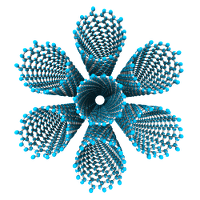Source code for sknano.generators._swnt_generator
# -*- coding: utf-8 -*-
"""
===============================================================================
SWNT structure generator (:mod:`sknano.generators._swnt_generator`)
===============================================================================
.. currentmodule:: sknano.generators._swnt_generator
.. todo::
Add methods to perform fractional translation and cartesian translation
before structure generation.
.. todo::
Handle different units in output coordinates.
"""
from __future__ import absolute_import, division, print_function, \
unicode_literals
__docformat__ = 'restructuredtext en'
import numpy as np
from sknano.core import pluralize
from sknano.core.math import Point
from sknano.structures import SWNT
from sknano.core.geometric_regions import Cuboid
from ._base import GeneratorBase
__all__ = ['SWNTGenerator']
[docs]class SWNTGenerator(GeneratorBase, SWNT):
"""Class for generating :class:`SWNT` structures.
Parameters
----------
*Ch : {:class:`python:tuple` or :class:`python:int`\ s}
Either a 2-tuple of integers (i.e., *Ch = [(n, m)]) or
2 integers (i.e., *Ch = [n, m]) specifying the chiral indices
of the nanotube chiral vector
:math:`\\mathbf{C}_h = n\\mathbf{a}_1 + m\\mathbf{a}_2 = (n, m)`.
nz : :class:`python:int`, optional
Number of repeat unit cells in the :math:`z` direction, along
the *length* of the nanotube.
basis : {:class:`python:list`}, optional
List of :class:`python:str`\ s of element symbols or atomic number
of the two atom basis (default: ['C', 'C'])
.. versionadded:: 0.3.10
element1, element2 : {str, int}, optional
Element symbol or atomic number of basis
:class:`~sknano.core.Atom` 1 and 2
.. deprecated:: 0.3.10
Use `basis` instead
bond : float, optional
:math:`\\mathrm{a}_{\\mathrm{CC}} =` distance between
nearest neighbor atoms. Must be in units of **Angstroms**.
Lz : float, optional
Length of nanotube in units of **nanometers**.
Overrides the `nz` value.
.. versionadded:: 0.2.5
tube_length : float, optional
Length of nanotube in units of **nanometers**.
Overrides the `nz` value.
.. deprecated:: 0.2.5
Use `Lz` instead
fix_Lz : bool, optional
Generate the nanotube with length as close to the specified
:math:`L_z` as possible. If `True`, then
non integer :math:`n_z` cells are permitted.
.. versionadded:: 0.2.6
autogen : bool, optional
if `True`, automatically generate structure data.
verbose : bool, optional
if `True`, show verbose output
Examples
--------
First, load the :class:`~sknano.generators.SWNTGenerator` class.
>>> from sknano.generators import SWNTGenerator
Now let's generate a :math:`\\mathbf{C}_{\\mathrm{h}} = (10, 5)`
:class:`SWNT` unit cell.
>>> swnt = SWNTGenerator((10, 5))
>>> swnt.save(fname='10,5_unit_cell.xyz')
>>> # note that there are two other alternative, but equivalent
>>> # means of passing arguments to SWNTGenerator constructor:
>>> # SWNTGenerator(10, 5) and SWNTGenerator(n=10, m=5)
Here's a nice ray traced rendering of the generated
:math:`(10, 5)` :class:`SWNT` unit cell.
.. image:: /images/10,5_unit_cell-01.png
"""
[docs] def generate(self):
"""Generate structure data."""
super().generate()
if self.L0 is not None and self.fix_Lz:
Lz_cutoff = 10 * self.L0 + 1
region_bounds = Cuboid(pmin=Point([-np.inf, -np.inf, 0]),
pmax=Point([np.inf, np.inf, Lz_cutoff]))
self.atoms.clip_bounds(region_bounds)
@classmethod
[docs] def generate_fname(cls, n=None, m=None, nz=None, fix_Lz=False,
**kwargs):
chirality = '{}{}'.format('{}'.format(n).zfill(2),
'{}'.format(m).zfill(2))
nz_fmtstr = '{:.2f}' if fix_Lz else '{:.0f}'
nz = ''.join((nz_fmtstr.format(nz), pluralize('cell', nz)))
fname_wordlist = (chirality, nz)
fname = '_'.join(fname_wordlist)
return fname
[docs] def save(self, fname=None, outpath=None, structure_format=None,
center_centroid=True, **kwargs):
"""Save structure data.
See :meth:`~sknano.generators.GeneratorBase.save` method
for documentation.
"""
if fname is None:
fname = self.generate_fname(n=self.n, m=self.m, nz=self.nz,
fix_Lz=self.fix_Lz)
super().save(fname=fname, outpath=outpath,
structure_format=structure_format,
center_centroid=center_centroid, **kwargs)
